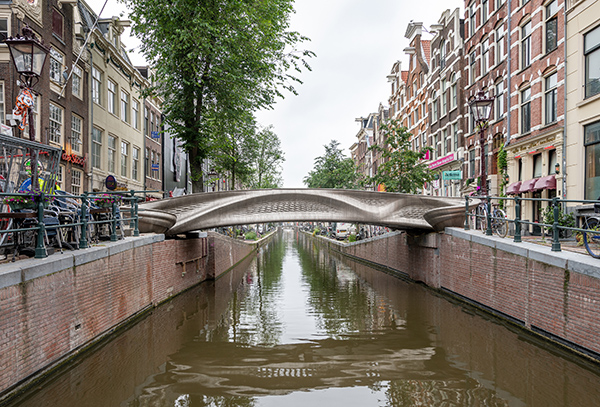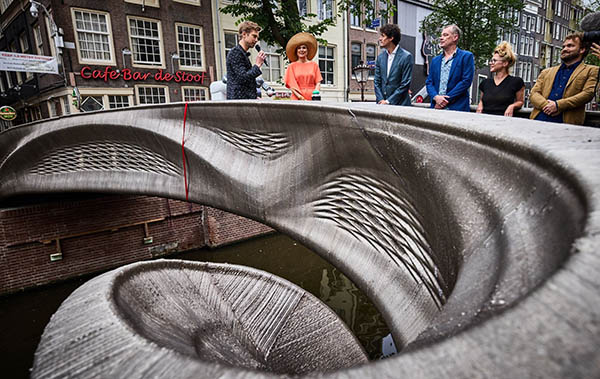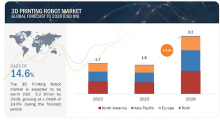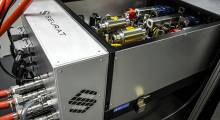The world's first stainless-steel, 3D-printed bridge officially opened today in Amsterdam. Queen Máxima of the Netherlands participated in the ceremony in the city's oldest neighborhood. Dutch startup MX3D proposed the architectural project in 2015 using its large-scale, robotic 3D printing technology.
“When we started with the concept, the bridge was more than 100 times bigger than any part ever 3D-printed in metal, and now [that] it’s finished, I still have good reasons to believe the bridge will remain the largest metal printed object for years to come,” said Gijs van der Velden, co-founder and CEO of MX3D.
From design to 'living laboratory'
The project was funded by the Lloyd's Register Foundation, and ABB, Air Liquide, ArcelorMittal, Autodesk, AMS Institute, and Lenovo helped MX3D realize its vision. The award-winning bridge was designed by Joris Laarman Lab, with Arup as lead engineer.
“A few years ago, we came up with the idea to use the robotic 3D-metal printers that we developed to print a functional, full-size steel bridge,” said Tim Geurtjens, co-founder of MX3D. “Together with the excitement of this crazy idea also came the realization that there was no way we could pull this off alone.”
“For a complex and crazy project like this to succeed, you need many smart and enthusiastic people,” he added. “We are very grateful that we had the opportunity to work with some of the top people and businesses in the field of robotics, engineering, welding technique, and software development.”
The proprietary MX3D printing technology uses off-the-shelf welding robots to build up metal objects layer by layer. The bridge design was created using generative design and topology optimisation techniques, which MX3D said allowed for design freedom and promised significant material reduction.
“The unique design of the bridge would not be possible without 3-D printing,” said Stijn Joosten, a structural engineer at Arup. “Figuring out the structural properties of 3D-printed steel is an essential step for the creation of architectural projects using digital tools. Printed steel behaves very differently compared to ordinary steel, which required new fundamental materials research with different calculation rules.”
“We built this research up from scratch, and it's great to see the physical end result now,” Joosten said. “Opening up a world of possibilities for architects, engineers, and designers, who can explore greater form freedom and create new shapes and structures which could not be created without the use of 3-D printing.”
Between 2017 and 2018, four robots 3D-printed the 12-meter (39.3-ft.) structure using more than 6,000 kg (13,200 lb.) of stainless steel.
Innovative in design and technology, the bridge serves as a “living laboratory,” according to MX3D. The “smart bridge” is equipped with a sensor network that will provide real-time data streams so that municipal authorities can explore the role of Internet of Things (IoT) systems in the built environment.
For instance, they could analyse anonymized crowd behaviour to better understand the impact of tourism in Amsterdam's Red Light District. The project also addresses questions about open data, data ethics, and citizen ownership of city analytics. The City of Amsterdam granted MX3D a two-year operations permit.
Smart sensor network feeds digital twin
MX3D's collaborators, which included The Alan Turing Institute, FORCE Technology, and the University of Twente, spent the past three years creating and installing the sensor network, representing its data flows in live models, and creating usable analytics on top of that data feeding into a digital twin of the bridge.
The bridge’s sensors collect structural measurements such as strain, rotation, load, displacement, and vibration, and also measure environmental factors such as air quality and temperature. The digital twin will help engineers measure the bridge’s health and monitor how it changes over its lifespan.
The sensor data will also be used to “teach” the bridge to understand what is happening on it, beginning with the ability to count how many people are crossing it and how quickly.
Researchers from Autodesk designed bespoke software and served as the primary systems integrator for the smart bridge. Autodesk worked closely with the partners of the Data Centric Engineering Programme at the Turing Institute as well as FORCE Technology and the University of Twente to design and install the sensor network.
Even in its prototype form, this network was useful when performing structural testing on the bridge. Load testing and materials testing were both conducted by the Data Centric Engineering team, which proved that the bridge is able to hold at least a 19.5 ton load, well above its ultimate design load.
“Extending our partnership with MX3D has provided Autodesk a platform to test and develop our IoT digital twin technologies to help MX3D make its bridge the most advanced smart structure in the world in its design, creation, and use,” said Alex Tessier, senior principal research analyst at Autodesk.
The Turing, the U.K.’s national institute for data science and artificial intelligence, is hosting the bridge data for the period covered by the bridge’s current operating permit and has conducted a thorough ethics review to ensure that the scientific goals of the project do not compromise the privacy of the public.
Using a custom data platform, the Turing supports researchers who require access to the sensor data stored in its secure cloud. The Turing researchers can also develop novel and advanced digital twin models for prototypes of the MX3D bridge and are now applying these techniques to evolve the digital twin of the physical bridge as it is used.
“When we couple 3D printing with digital twin technology, we can then accelerate the infrastructure design process, ensuring that we design optimal and efficient structures with respect to environmental impact, architectural freedom, and manufacturing costs,” said Mark Girolami, program director for data-centric engineering at the Turing.

Government helped enable innovation
As governments worldwide strive to build smarter cities, this research project will help experts improve the design, operation, and safety of future 3D-printed structures and IoT systems under all conditions, said the partners.
MX3D noted that the support of the city of Amsterdam, stadsdeel Centrum, and its chief technology office were essential to the project's success. In addition, the project enalbed the company to gain worldwide recognition for its software license that turns a welding robot into a high-end 3D metal printer. MX3D raised $2.7 million to launch its M1 metal additive manufacturing system in April.
In the government-funded BRIDE project, the University of Twente, TU Delft, the Amsterdam Institute of Metropolitan Studies, and MX3D are studying societal reactions to such construction. What do citizens want from smarter infrastructures, and do they even want it? What are the ethical boundaries data collection should adhere to? Should a city collaborate or even be in the lead? How can we design the data sharing equitably?
Bridge faced challenges
Groundbreaking projects like the 3D-printed metal bridge inevitably run into barriers and unexpected changes, noted MX3D.
The original design concept was changed considerably because of engineering concerns, and printing it onsite turned out unfeasible due to safety and technical concerns, said the company. In March 2017, the printing and assembly of large segments of the bridge began, but final placement had to be postponed nearly two years until the renovation of the canal walls was completed, and all the formalities were ironed out.
MX3D said its engineers have continued working on robots that can autonomously 3D-print infrastructure. A robot was successful in triangulating its position and print while placed on the bridge. The company said this validated its vision and confirmed that robots printing bridges without human intervention are not science fiction anymore.
About the Author
Follow Robotics 24/7 on Linkedin
Article topics
Email Sign Up
















